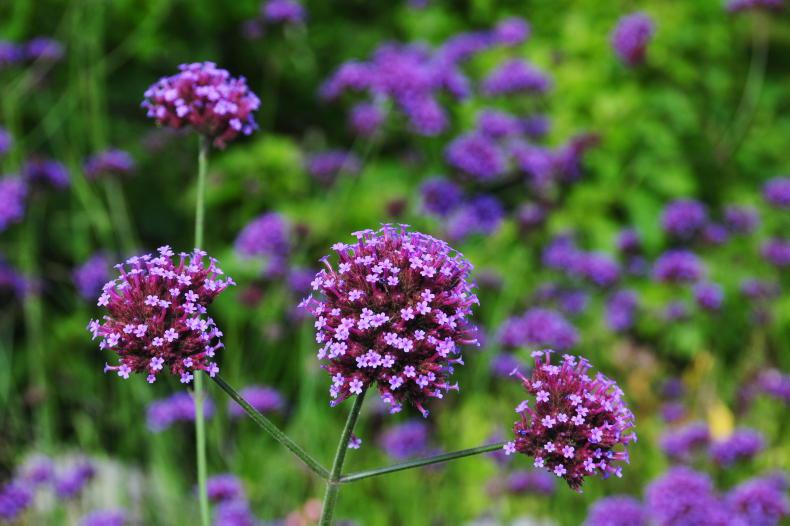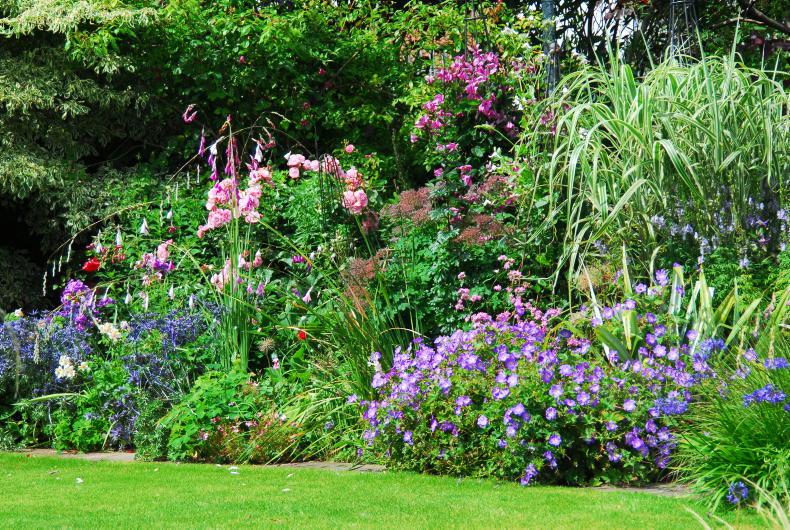The advice to plant perennial flowers in groups of three, five or seven has been a standard approach for many decades.
The use of uneven numbers helps to make a group of plants look more informal, but modern planting styles are aiming to create even more informality.
The older approach to planting tended to give rounded groups, which linked with others to make up a border of plants.
While this can give very attractive results, modern designers are taking things a bit further. Much has been made of ‘natural planting’ as a new approach, but this is not the first time that naturalistic planting has been advocated in the history of gardening.
More than a century ago, Irish-born William Robinson, championed the cause of natural planting, writing several books on the subject, his ideas influencing the design of many gardens over several decades. Using plants in a natural way particularly suited gardens made on sites of natural beauty. Many gardens are still considered to be Robinsonian in style, which was to plant flowers in drifts and swathes with outliers to mimic how they might appear in nature. But Robinson made no distinction between native plants and introduced species, and he did not have the benefit of the insight of the science of ecology, which had not been defined as a separate scientific discipline in his time, the renewed interest in naturalistic planting is closely based on ecological principles.
Some designers adopt a very strict alignment with ecological thinking and use only native species, while others take up the broad sense of the scientific principles but are more flexible in their approach, at least in garden planting. While it might be essential to be careful about planting in a ‘wild’ or semi-wild setting, the garden is an artificial creation where the aim is to create decorative beauty. Adopting the most important principle of the ecological approach would be to see plants as part of a plant community, and indeed a community of living organisms, including animals. When grown in a community, plants enjoy the same soil conditions, so they look ‘at home’ together. Even so, they occupy different ‘niches’ within the grouping, some taller, some more scrambling, for instance, or some spring and some summer-flowering.
Without going into the principles too much, there are a couple of things that can be done to follow this naturalistic style. First, choose plants that have the same requirements of shelter, soil and sunlight, and match them to the available conditions. There is a fairly good chance that these will work well together. Next take a lead from wild plants in how they associate by spreading or self-sowing. Wildflowers are nearly always seen in drifts – a swathe of plants of irregular shape and size with some outlying single plants or small groups.
There is scope for endless variation of group sizes and distances apart. Even within groups, plants can be more closely planted or spread a little. If this approach is adopted for even a single species, it can transform a garden, giving it a completely different look, and a lot more ‘life’.
Self-sown purple top

Purple Top.
Buenos Aires verbena, or purple top as it is known to some people has been enjoying a tremendous vogue in recent years. And an exceptionally good plant it is, with its great airy stems topped with sparkling purple flowers. It is a great draw with butterflies, worth growing for this facet alone. But it associates well with many plants, helping to soften borders. It also is very easy to grow, shedding lots of seeds and coming up where it finds a congenial spot. If you like this kind of unpredictable gardening, which is also ecological, be sure to leave verbena to shed its seeds. They might even come up in the compost heap in future. Or if you have never grown it, try some seeds next spring and plant them out to flower the same season – it is quick, even though it is a perennial.
Trees, shrubs and roses
Prepare ground for planting if not already done. Check that trees recently planted are properly staked and stake any old shrubs that appear top-heavy. Check on wall-trained climbers that their support is solid. Prune late-flowering roses.
Fruit, vegetables and herbs
The vegetable garden needs to be tidied before winter. Vegetables that can be stored, such as carrots, turnips and onions, can be harvested and stored in suitable conditions. Fruit crops can be picked and stored using flat shelves or trays.
Flowers
Bedding that is gone over can be removed in preparation for planting spring bedding flowers and spring bulbs. The garden shops all have their spring bedding in now. Perennial flowers can be planted or lifted and divided for existing plants.
Lawn
Good growth in recent weeks has seen lawns in good order but moss is asserting itself too. Sulphate of iron can be applied if moss was a problem last winter and spring. If there are any bare spots, some lawnseed can be sown.
Greenhouse and house plants
Most of the greenhouse crops can be cleared soon. Throw out any old plants that are past their best or half-dead plants because they are a source of pests and diseases. Tidy up all debris and reduce watering. Stop feeding plants.
Read more
In the Garden with Gerry Daly: long-lasting bear’s breeches
In the garden with Gerry Daly: minty monarda
The advice to plant perennial flowers in groups of three, five or seven has been a standard approach for many decades.
The use of uneven numbers helps to make a group of plants look more informal, but modern planting styles are aiming to create even more informality.
The older approach to planting tended to give rounded groups, which linked with others to make up a border of plants.
While this can give very attractive results, modern designers are taking things a bit further. Much has been made of ‘natural planting’ as a new approach, but this is not the first time that naturalistic planting has been advocated in the history of gardening.
More than a century ago, Irish-born William Robinson, championed the cause of natural planting, writing several books on the subject, his ideas influencing the design of many gardens over several decades. Using plants in a natural way particularly suited gardens made on sites of natural beauty. Many gardens are still considered to be Robinsonian in style, which was to plant flowers in drifts and swathes with outliers to mimic how they might appear in nature. But Robinson made no distinction between native plants and introduced species, and he did not have the benefit of the insight of the science of ecology, which had not been defined as a separate scientific discipline in his time, the renewed interest in naturalistic planting is closely based on ecological principles.
Some designers adopt a very strict alignment with ecological thinking and use only native species, while others take up the broad sense of the scientific principles but are more flexible in their approach, at least in garden planting. While it might be essential to be careful about planting in a ‘wild’ or semi-wild setting, the garden is an artificial creation where the aim is to create decorative beauty. Adopting the most important principle of the ecological approach would be to see plants as part of a plant community, and indeed a community of living organisms, including animals. When grown in a community, plants enjoy the same soil conditions, so they look ‘at home’ together. Even so, they occupy different ‘niches’ within the grouping, some taller, some more scrambling, for instance, or some spring and some summer-flowering.
Without going into the principles too much, there are a couple of things that can be done to follow this naturalistic style. First, choose plants that have the same requirements of shelter, soil and sunlight, and match them to the available conditions. There is a fairly good chance that these will work well together. Next take a lead from wild plants in how they associate by spreading or self-sowing. Wildflowers are nearly always seen in drifts – a swathe of plants of irregular shape and size with some outlying single plants or small groups.
There is scope for endless variation of group sizes and distances apart. Even within groups, plants can be more closely planted or spread a little. If this approach is adopted for even a single species, it can transform a garden, giving it a completely different look, and a lot more ‘life’.
Self-sown purple top

Purple Top.
Buenos Aires verbena, or purple top as it is known to some people has been enjoying a tremendous vogue in recent years. And an exceptionally good plant it is, with its great airy stems topped with sparkling purple flowers. It is a great draw with butterflies, worth growing for this facet alone. But it associates well with many plants, helping to soften borders. It also is very easy to grow, shedding lots of seeds and coming up where it finds a congenial spot. If you like this kind of unpredictable gardening, which is also ecological, be sure to leave verbena to shed its seeds. They might even come up in the compost heap in future. Or if you have never grown it, try some seeds next spring and plant them out to flower the same season – it is quick, even though it is a perennial.
Trees, shrubs and roses
Prepare ground for planting if not already done. Check that trees recently planted are properly staked and stake any old shrubs that appear top-heavy. Check on wall-trained climbers that their support is solid. Prune late-flowering roses.
Fruit, vegetables and herbs
The vegetable garden needs to be tidied before winter. Vegetables that can be stored, such as carrots, turnips and onions, can be harvested and stored in suitable conditions. Fruit crops can be picked and stored using flat shelves or trays.
Flowers
Bedding that is gone over can be removed in preparation for planting spring bedding flowers and spring bulbs. The garden shops all have their spring bedding in now. Perennial flowers can be planted or lifted and divided for existing plants.
Lawn
Good growth in recent weeks has seen lawns in good order but moss is asserting itself too. Sulphate of iron can be applied if moss was a problem last winter and spring. If there are any bare spots, some lawnseed can be sown.
Greenhouse and house plants
Most of the greenhouse crops can be cleared soon. Throw out any old plants that are past their best or half-dead plants because they are a source of pests and diseases. Tidy up all debris and reduce watering. Stop feeding plants.
Read more
In the Garden with Gerry Daly: long-lasting bear’s breeches
In the garden with Gerry Daly: minty monarda







 This is a subscriber-only article
This is a subscriber-only article










SHARING OPTIONS: